Imprinted tumor suppressor gene ARHI induces apoptosis correlated with changes in DNA methylation in pancreatic cancer cells
- PMID: 21472283
- PMCID: PMC3097896
- DOI: 10.3892/mmr_00000301
Imprinted tumor suppressor gene ARHI induces apoptosis correlated with changes in DNA methylation in pancreatic cancer cells
Abstract
Aplesia Ras homologue member I (ARHI, DIRAS3) is a Ras-related imprinted growth inhibitory gene whose expression is down-regulated in the majority of breast and ovarian cancers. This study investigated the inhibitory function of ARHI in pancreatic cancer. Six pancreatic cancer cell lines, tumor xenografts in nude mice and 20 pancreatic cancer tissue sections were analyzed. ARHI is widely expressed in ductal and acinar cells of normal pancreatic tissue, but is down-regulated or lost in approximately 50% of pancreatic cancers. Aberrant methylation of the ARHI locus was found in five pancreatic cancer cell lines, which exhibited down-regulation or loss of ARHI expression. Hypermethylation was detected in five cell lines (5/5, 100%) at CpG island I, in two cell lines (2/5, 40%) at CpG island II and in four cell lines (4/5, 80%) at CpG island III. Re-expression of ARHI significantly inhibited the growth of pancreatic cancer cells. This inhibition was associated with the induction of apoptosis. Treatment with the demethylating agent 5-aza-2'deoxycytidine (5-aza-dC) restored ARHI mRNA expression, inhibited cell growth and induced apoptosis in PANC-1 and P3 human pancreatic cancer cells in culture. In nu/nu mice, 5-aza-dC also inhibited the growth of PANC-1 xenografts and induced apoptosis, as observed by TUNEL staining. These effects were associated with the re-expression of ARHI protein. Therefore, ARHI may serve as a growth inhibitory gene in a significant fraction of pancreatic cancers. Re-expression of ARHI significantly induced the apoptosis of pancreatic cancer cells. A demethylation agent reduced human pancreatic cancer cell line growth in conjunction with ARHI re-expression.
Figures

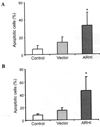
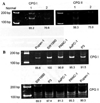
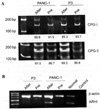
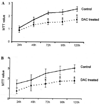
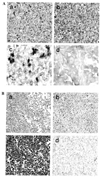
Similar articles
-
Aberrant methylation and silencing of ARHI, an imprinted tumor suppressor gene in which the function is lost in breast cancers.Cancer Res. 2003 Jul 15;63(14):4174-80. Cancer Res. 2003. PMID: 12874023
-
Imprinted tumor suppressor genes ARHI and PEG3 are the most frequently down-regulated in human ovarian cancers by loss of heterozygosity and promoter methylation.Cancer. 2008 Apr 1;112(7):1489-502. doi: 10.1002/cncr.23323. Cancer. 2008. PMID: 18286529
-
Re-expression of ARHI (DIRAS3) induces autophagy in breast cancer cells and enhances the inhibitory effect of paclitaxel.BMC Cancer. 2011 Jan 19;11:22. doi: 10.1186/1471-2407-11-22. BMC Cancer. 2011. PMID: 21244707 Free PMC article.
-
The Role of Methylation in the CpG Island of the ARHI Promoter Region in Cancers.Adv Exp Med Biol. 2020;1255:123-132. doi: 10.1007/978-981-15-4494-1_10. Adv Exp Med Biol. 2020. PMID: 32949395 Review.
-
Epigenetic regulation of ARHI in breast and ovarian cancer cells.Ann N Y Acad Sci. 2003 Mar;983:268-77. doi: 10.1111/j.1749-6632.2003.tb05981.x. Ann N Y Acad Sci. 2003. PMID: 12724231 Review.
Cited by
-
A randomized, phase II trial of oral azacitidine (CC-486) in patients with resected pancreatic adenocarcinoma at high risk for recurrence.Clin Epigenetics. 2022 Dec 3;14(1):166. doi: 10.1186/s13148-022-01367-8. Clin Epigenetics. 2022. PMID: 36463226 Free PMC article. Clinical Trial.
-
Effect of ARHI on lung cancer cell proliferation, apoptosis and invasion in vitro.Mol Biol Rep. 2013 Mar;40(3):2671-8. doi: 10.1007/s11033-012-2353-x. Epub 2012 Dec 18. Mol Biol Rep. 2013. PMID: 23247805
-
The expression of aplysia ras homolog I (ARHI) and its inhibitory effect on cell biological behavior in esophageal squamous cell carcinoma.Onco Targets Ther. 2017 Feb 27;10:1217-1226. doi: 10.2147/OTT.S125742. eCollection 2017. Onco Targets Ther. 2017. PMID: 28280356 Free PMC article.
-
Effects of ARHI on cell cycle progression and apoptosis levels of breast cancer cells.Tumour Biol. 2012 Oct;33(5):1403-10. doi: 10.1007/s13277-012-0388-1. Epub 2012 Apr 14. Tumour Biol. 2012. PMID: 22528939
-
Anticancer Natural Compounds as Epigenetic Modulators of Gene Expression.Curr Genomics. 2017 Apr;18(2):175-205. doi: 10.2174/1389202917666160803165229. Curr Genomics. 2017. PMID: 28367075 Free PMC article. Review.
References
-
- Smakman N, Borel Rinkes IH, Voest EE, Kranenburg O. Control of colorectal metastasis formation by K-Ras. Biochim Biophys Acta. 2005;1756:103–114. - PubMed
-
- Kranenburg O. The KPAS oncogene: past, present, and future. Biochim Biophys Acta. 2005;1756:81–82. - PubMed
-
- Schubbert S, Shannon K, Bollag G. Hyperactive Ras in developmental disorders and cancer. Nat Rev Cancer. 2007;7:295–308. - PubMed
-
- Hingorani SR, Petricoin EF, Maitra A, et al. Preinvasive and invasive ductal pancreatic cancer and its early detection in the mouse. Cancer Cell. 2003;4:437–450. - PubMed
Grants and funding
LinkOut - more resources
Full Text Sources
Other Literature Sources
Research Materials

